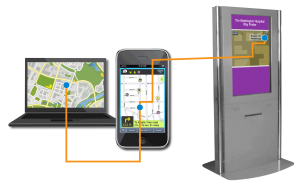Digital Wayfinding: Kiosk, Web or Mobile?
One of the questions I frequently receive :
What is the best way to display the Digital Wayfinding Application? On a Kiosk, the Web or on a Mobile Phone?
This is indeed a very good question because everyone wants the investment to pay off. To be as effective as possible.
In Digital Wayfinding terms: The Wayfinding Application should be able to be used as often as possible and by as many people as possible.
Kiosk
For starters, A Kiosk or LCD Touch Screen is a prime service point for general assistance matters. Easy to spot. Easy to use. The contents are easy to change and adjust to any situation. Offering the Wayfinding Application through a Kiosk should always be considered, even though it does have additional cost in hardware and installation.
A Kiosk or LCD Touch Screen running the Digital Wayfinding Application is On-Site, allowing the visitors to get directions inside the Building, there where they need it. Conveniently located close to the entrance(s)/elevators can it print the generated directions or transfer the on-screen directions to Mobile Phone.
Because a Kiosk screen has a lot of real estate, other features can be integrated, like opening hours, a Room Management System, RSS News feeds, etc.
Be sure to make the whole kiosk installation ADA compliant.
Mobile Web
Publishing the Wayfinding Application on the Web is a sure way to get it used. In the comfortable setting of their home, visitors-to-be can plan their visit and print the directions. No pressure there.
But once published on the Web, the Wayfinding Application can offer more use.
Imagine the setting as described under I, a Kiosk nearby the entrance. While a lot of people will use the Kiosk, many older visitors like the personal touch that comes with asking for assistance. Or maybe they are just too overwhelmed by the Kiosk’s features. Or are unsure how to use it.
Anyway, they walk on and ask at the reception for directions. In the preferred scenario, we also have the Web version of The Wayfinding Application running on the computers at the Reception. After receiving the inquiry for directions the staff member can generate the route, explain it, print it out and give it along. Running the Web Wayfinding Application on strategic PC’s within the building, for example on the computers of volunteers, perfectly complements customer service.
Offering a text-only version of the Wayfinding Application and making it compliant to the Section 508 standards and W3C WCAG will improve the accessibility.
Mobile App
Always available for help and ready to provide it at the touch of a finger, only to you. The Mobile Wayfinding App is always there, never complaining. Just keep it charged.
The ability of the Smart Phone to read QR codes offers a few very interesting team plays in a total wayfinding solution. For example:
-a QR code on an appointment paper of the doctors offices, indicating the route to the Hospital, including where to park.
-a QR code in the parking lot or parking garage, coded to launch the Wayfinding Application and indication of the current position, so that the visitor only needs to select the destinations for the route to display.
-a QR code on the Kiosk indicating to transfer the information on-screen to the Smart Phone. Try it here: temple.here2theresoftware.com/kiosk
This web page indicates where the kiosk is located on the map. Now choose a destination. This can be done by searching by alphabet or the directory. Note that when a route is generated, a QR code is generated as well. Now scan the QR code to Mobile.
If you were on-site on the Temple University Campus using the Kiosk for directions, then you just have transferred the route information to your Mobile, for instructions underway.
**Conclusion:
So the answer is, that displaying it on all channels will cover the most ground and will give the biggest bang. Besides, digitizing the hallways and destinations is the most work intensive part. Displaying it on a Kiosk, The Web or a Mobile App. is just a matter of adjusting the formatting.
Interestingly enough, this also means that a Digital Wayfinding System created with Here2There is already for Google Glasses prepared as well.
Information or Comments?
Write me: support@here2theresoftware.com

